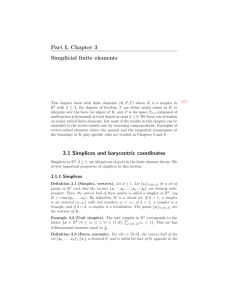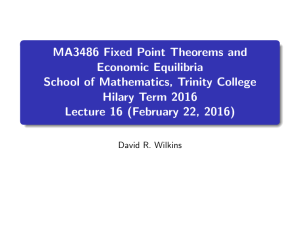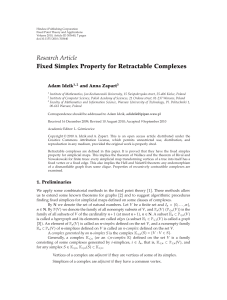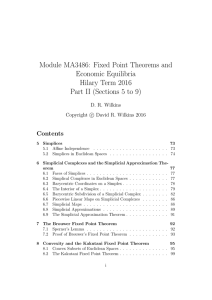Faculty of Engineering, Mathematics and Science School of Mathematics
advertisement
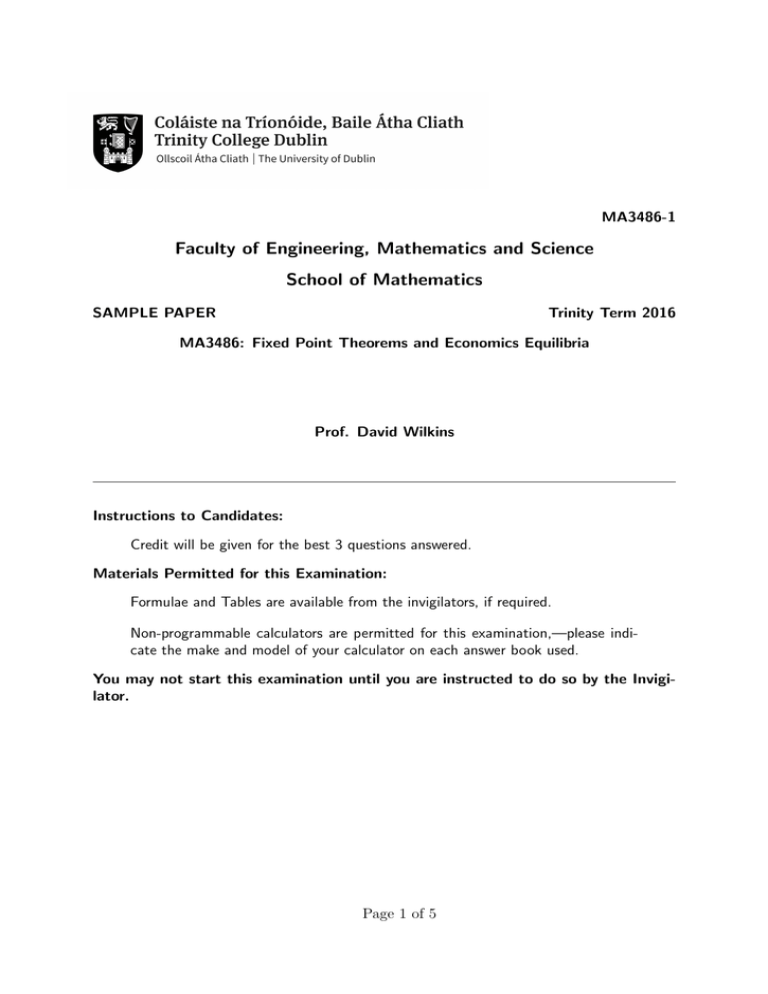
MA3486-1
Faculty of Engineering, Mathematics and Science
School of Mathematics
SAMPLE PAPER
Trinity Term 2016
MA3486: Fixed Point Theorems and Economics Equilibria
Prof. David Wilkins
Instructions to Candidates:
Credit will be given for the best 3 questions answered.
Materials Permitted for this Examination:
Formulae and Tables are available from the invigilators, if required.
Non-programmable calculators are permitted for this examination,—please indicate the make and model of your calculator on each answer book used.
You may not start this examination until you are instructed to do so by the Invigilator.
Page 1 of 5
MA3486-1
1. (a) Let X be a subset of n-dimensional Euclidean space Rn . What is meant by saying
that a collection of subsets of Rn covers X? What is an open cover of X.
(4 points)
(b) Let X be a closed bounded set in n-dimensional Euclidean space, and let V be
an open cover of X. Prove that there exists a positive real number δL with the
property that, given any point u of X, there exists a member V of the open cover
V for which
{x ∈ X : |x − u| < δL } ⊂ V.
(16 points)
2. Let X and Y be subsets of Euclidean spaces Rn and Rm respectively. A correspondence
Φ: X ⇒ Y assigns to each point x of X a subset Φ(x) of Y . The correspondence
Φ: X ⇒ Y is said to be upper hemicontinuous at a point p of X if, given any set V in
Y that is open in Y and satisfies Φ(p) ⊂ V , there exists some positive real number δ
such that Φ(x) ⊂ V for all x ∈ X satisfying |x − p| < δ. Also the correspondence
Φ: X ⇒ Y is said to be lower hemicontinuous at a point p of X if, given any set V in Y
that is open in Y and satisfies Φ(p) ∩ V 6= ∅, there exists some positive real number δ
such that Φ(x) ∩ V 6= ∅ for all x ∈ X satisfying |x − p| < δ.
(a) Let Φ: R ⇒ R be the
Φ(x) =
correspondence defined such that
y ∈ R : x2 − 1 ≤ y ≤ x2 + 1
{y ∈ R : x − 1 ≤ y ≤ 1 − x}
y ∈ R : y2x ≤ 1
if x < 0;
if 0 ≤ x < 1;
if x ≥ 1.
Answer the following, fully justifying your answers:—
(i) Is Φ: R → R is upper hemicontinuous at x = 0?
(ii) Is Φ: R → R is lower hemicontinuous at x = 0?
(iii) Is Φ: R → R is upper hemicontinuous at x = 1?
(iv) Is Φ: R → R is lower hemicontinuous at x = 1?
(10 points)
Page 2 of 5
MA3486-1
(b) Let X and Y be subsets of Rn and Rm respectively, and let Φ: X ⇒ Y be a
correspondence from X to Y that is compact-valued and upper hemicontinuous.
Let K be a compact subset of X. Prove that Φ(K) is a compact subset of Y .
(5 points)
(c) Let X and Y be subsets of Rn and Rm respectively, and let Φ: X ⇒ Y be a
correspondence from X to Y that is lower hemicontinuous. Let f : X × Y → R
be a continuous real-valued function on X × Y , and let c be a real number. Prove
that
{x ∈ X : there exists y ∈ Φ(x) for which f (x, y) > c}
is open in X.
(5 points)
(End of Question)
3. (a) What is a simplex? What is the dimension of a simplex? What are the barycentric
coordinates of a point of simplex with respect to the vertices of that simplex?
What is the barycentre of a simplex? What is meant by saying that a simplex τ is
a face of a simplex σ? What is the interior of a simplex?
(6 points)
(Question continues on the next page)
(b) Prove that any point of a simplex belongs to the interior of a unique face of that
simplex.
(3 points)
(c) The point (3, 3) of R2 belongs to the triangle in R2 with vertices (−1, 0), (3, 2) and
(4, 4). Determine the barycentric coordinates of (3, 3) with regard to the vertices
of this triangle.
(4 points)
Page 3 of 5
MA3486-1
Let K be a simplicial complex. The first barycentric subdivision K 0 of K is the simplicial
complex consisting of simplices whose vertex sets are of the form {σ̂0 , σ̂1 , . . . , σ̂r }, where
σ0 , σ1 , . . . , σr are simplices of K, σi−1 is a proper face of σi for i = 1, 2, . . . , r and σ̂i
denote the barycentre of the simplex σi for i = 0, 1, 2, . . . , r.
(d) Let σ be a 5-dimensional simplex with vertices v0 , v1 , v2 , v3 , v4 , let K be the
simplicial complex consisting of the simplex σ together with all its faces, let K 0 be
the first barycentric subdivision of σ, let
x = 41 v0 + 61 v1 + 13 v3 + 41 v4 ,
and let τ be the unique simplex of K 0 that contains the point x in its interior (so
that x belongs to τ but does not belong to any proper face of τ ). Determine the
barycentric coordinates of the vertices of τ with respect to the vertices of σ, and
determine the barycentric coordinates of the point x with respect to the vertices
of τ .
(7 points)
(End of Question)
4. (a) State and prove Sperner’s Lemma.
(13 points)
(Question continues on the next page)
Page 4 of 5
MA3486-1
(b) Let M be an m × n matrix, and let
(
∆P =
(p1 , p2 , . . . , pm ) ∈ Rm : pi ≥ 0 for i = 1, 2, . . . , m, and
m
X
)
pi = 1 ,
i=1
(
∆Q =
(q1 , q2 , . . . , qn ) ∈ Rn : qi ≥ 0 for i = 1, 2, . . . , n, and
n
X
)
qj = 1 ,
j=1
and let
T
f (p, q) = p M q =
m X
n
X
Mi,j pi qj
i=1 j=1
for all p ∈ ∆P and q ∈ ∆Q . Prove von Neumann’s Minimax Theorem, which
asserts that there exist p∗ ∈ ∆P and q∗ ∈ ∆Q such that
f (p, q∗ ) ≤ f (p∗ , q∗ ) ≤ f (p∗ , q)
for all p ∈ ∆P and q ∈ ∆Q .
(7 points)
[You may use, without proof, Kakutani’s Fixed Point Theorem which asserts that if
Φ: X ⇒ X is a correspondence with closed graph which maps points of a non-empty,
compact and convex subset X of a Euclidean space to non-empty convex subsets of
X then there exists at least one “fixed point” x∗ for Φ characterized by the property
x∗ ∈ Φ(x∗ ). You may also use, without proof, Berge’s Maximum Theorem, which in
this context ensures that if
µP (q) = sup{f (p, q) : p ∈ ∆P }
and
P (q) = {p ∈ ∆P : f (p, q) = µP (q)}
for all q ∈ ∆Q then the function µP : ∆Q → R is continuous and the correspondence
P : ∆Q ⇒ ∆P is non-empty-valued, compact-valued and upper hemicontinuous and thus
has closed graph.]
(End of Question)
c TRINITY COLLEGE DUBLIN, THE UNIVERSITY OF DUBLIN 2016
Page 5 of 5








